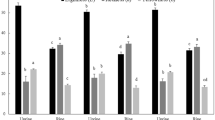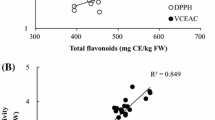Abstract
Soluble solid, sugar, organic acid, flavonol and carotenoid content were determined in seabuckthorn berries of the three German cultivars Askola, Hergo and Leikora, collected at different harvesting times, to provide a more thorough knowledge of quality changes occurring during ripening of the berries. The main organic acids were malic (1940–4660 mg/100 g), quinic (810–2820 mg/100 g), ascorbic (180–370 mg/100 g) and citric acid (90–160 mg/100 g). In all three cultivars a marked decline in total organic acid concentration was observed during ripening. The pattern of variation of sugars, glucose (0.26–2.10 g/100 g) and fructose (0.14–0.54 g/100 g), was somewhat different among the three cultivars. In all three cultivars ascorbic acid concentration decreased during ripening. The main flavonols were isorhamnetin (350–660 mg/kg), quercetin (30–100 mg/kg) and kaempferol (2–5 mg/kg). The trends of flavonol content during ripening were quite different among the three cultivars. The main carotenoids were zeaxanthin (30–150 mg/kg), β-carotene (3–50 mg/kg) and β-criptoxanthin (5–19 mg/kg). The genotype seemed to affect both the extent of carotenoid accumulation and the carotenoid profile but in all three cultivars ripening was accompanied by an increase in total carotenoid concentration. The various classes of antioxidants showed quite different patterns of variation during ripening, achieving their maximum level at different harvesting dates.














Similar content being viewed by others
References
Li TSC, Schroeder WR (1996) Hort Tech 6:370–380
Yang B, Kallio H (2002) Trends Food Sci Technol 13:160–167
Beveridge T, Li TSC, Oomah DB, Smith A (1999) J Agric Food Chem 47:3480–3488
Tang X, Tigerstedt PMA (2001) Scientia Hort 88:203–214
Gao X, Ohlander M, Jeppsson N, Björk L, Trajkovski V (2000) J Agric Food Chem 48:1485–1490
Yang B, Karlsson R, Oksman P, Kallio H (2001) J Agric Food Chem 49:5620–5629
Eccleston C, Yang B, Tahvonen R, Kallio H, Rimbach GH, Minihane A (2002) J Nutr Biochem 13:346–354
Yang B, Kalimo KO, Mattila LM, Kallio SE, Katajisto JK, Peltola OJ, Kallio HP (1999) J Nutr Biochem 10:622–630
Johansson AK, Korte H, Yang B, Stanley JC, Kallio HP (2000) J Nutr Biochem 11:491–495
Cheng J, Kondo K, Suzuki Y, Ikeda Y, Meng X, Umemura K (2003) Life Sciences 72:2263–2271
Geetha S, Sai Ram M, Singh V, Ilavazhagan G, Sawhney RC (2002) J Ethnopharmacol 79:373–378
Kallio H, Yang B and Peippo P (2002) J Agric Food Chem 50:6136–6142
Tang X (2002) J Hort Sci Biotechnol 77: 177–185
Rösch D, Bergmann M, Knorr D, Kroh LW (2003) J Agric Food Chem 51:4233–4239
Jeppsson N, Gao X (2000) Agric Food Sci Finl 9:17–22
Tang X, Kalviainen N and Tuorila H (2001) Lebensm-Wiss u-Technol 34:102–110
Hakkinen S, Auriola S (1998) J Chromatogr A 829:91–100
Hart DJ, Scott KJ (1995) Food Chem 54:101–111
Gatke R, Klein G, Wolf D (1990) Erwerbsobstbau 32(8): 224–226
Rousi A, Aulin H (1977) Ann Agric Fenn 16:80–87
Macheix JJ, Fleuriet A, Billot J (1990) Fruit phenolics. CRC, Boca Raton, pp149–221
Dixon RA, Paiva NL (1995) Plant Cell 7:1085–1097
Hertog MGH, Hollman PCH and Katan MB (1992) J Agric Food Chem 40:2379–2383
Hakkinen SH, Karenlampi SO, Heinonen IM, Mykkanen HM, Torronen AR (1999) J Agric Food Chem 47:2274–2279
Hollman PCH, Arts ICW (2000) J Sci Food Agric 80:1081–1093
Yamamoto N, Moon JH, Tsushida T, Nagao A, Terao J (1999) Arch Biochem Biophys 372:347–354
Ibarra M, Perez-Vizcaino F, Cogolludo A, Duarte J, Zaragoza-Arnaez F, Lopez-Lopez JG, Tamargo J (2002) Planta Med 68:307–310
Yokozawa T, Kim HY, Cho EJ, Choi JS, Chung HY (2002) J Agric Food Chem 50:5490–5495
Kudritskaya SE, Zagorodskaya LM, Shishkina EE (1989) Chem Nat Comp 25:724–725
Sergeeva NV, Shapiro DK, Bandyukova VA, Anikhimovskaya LV, Narizhnaya TI (1979) Khimiya Prirodnykh Soedinenii 1:100–101
Mangels AR, Holden JM, Beecher GR, Forman MR, Lanza E (1993) J Am Diet Assoc 93:284–296
Johnson EJ, Hammond BR, Yeum KJ, Qin J, Wang XD, Castaneda C, Snodderly DM, Russell RM (2000) Am J Clin Nutr 71:1555–1562
Chasan-Taber L, Willett WC, Seddon JM, Stampfer MJ, Rosner B, Colditz GA, Speizer FE, Hankinson SE (1999) Am J Clin Nutr 70:509–516
Albrecht HJ (1990) Gartenbau 37:207–208
Author information
Authors and Affiliations
Corresponding author
Rights and permissions
About this article
Cite this article
Raffo, A., Paoletti, F. & Antonelli, M. Changes in sugar, organic acid, flavonol and carotenoid composition during ripening of berries of three seabuckthorn (Hippophae rhamnoides L.) cultivars. Eur Food Res Technol 219, 360–368 (2004). https://doi.org/10.1007/s00217-004-0984-4
Received:
Published:
Issue Date:
DOI: https://doi.org/10.1007/s00217-004-0984-4




